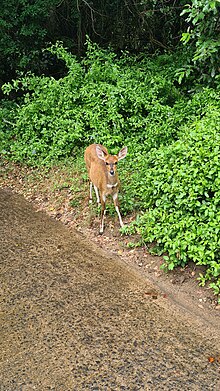| This article may incorporate text from a large language model. It may include hallucinated information or fictitious references. Copyright violations or claims lacking verification should be removed. Additional guidance is available on the associated project page. (December 2024) |
The Zimbali Estate Coastal Forest is a pristine and biodiverse coastal forest located in the province of KwaZulu-Natal, South Africa. Situated within Zimbali Estate, the forest is a unique and vital ecosystem that showcases the region's rich natural heritage. The forest's proximity to the Indian Ocean, coupled with its diverse plant and animal life, makes it a significant area for ecological research, conservation, and eco-tourism.
Geography and Location
The Zimbali Estate coastal forest is nestled along the eastern coastline of South Africa, approximately 30 kilometers north of the city of Durban. It covers an area of approximately 700 hectares and is situated within the broader Zimbali Estate, an upscale residential and leisure development. The forest's boundary extends from the sandy shores of the Indian Ocean to the fringes of Zimbali Estate, creating a transition between the natural world and human habitation.
Flora and Fauna
Zimbali Estate is renowned for its remarkable biodiversity, housing a plethora of plant and animal species unique to the region. The Zimbali Estate coastal forest's proximity to both the ocean and the dunes creates a dynamic habitat that supports a wide variety of life forms.
Flora
The forest boasts a diverse array of plant species, ranging from towering indigenous trees to delicate ferns. Notable tree species include the Milkwood (Sideroxylon inerme), Forest Fever Tree (Anthocleista grandiflora), and Natal Mahogany (Trichilia emetica). These trees provide essential habitats for various bird species, insects, and small mammals.
Fauna
Zimbali Estate's coastal forest is a haven for animal species adapted to coastal and forested environments. It is home to a range of bird species, including the Purple-crested Turaco (Tauraco porphyreolophus), Crowned Eagle (Stephanoaetus coronatus), and the elusive Green Malkoha (Ceuthmochares aereus). Mammals such as the Blue Duiker (Philantomba monticola), Vervet Monkey (Chlorocebus pygerythrus), and Bushbuck (Tragelaphus sylvaticus) can also be found within the forest's lush undergrowth.
The African Crowned Eagle listed by the IUCN as Near Threatened currently breeds in Zimbali Estate, making it a critical ecosystem for the species survival. Additionally, to promote their survival the environmental team at the estate carefully track juvenile eagles with a solar-powered GPS backpack.
Tragelaphus scriptus (Bushbuck)

Zimbali Estate is renowned for its vibrant bushbuck population, thanks to a comprehensive management program overseen by the Zimbali Estate Environmental Management Committee. This program includes monitoring, relocation, and the introduction of new individuals to maintain genetic diversity and prevent overpopulation due to the absence of natural predators, aiming to ensure a balance between bushbuck numbers and available resources. Notably solitary, bushbuck typically appear as females with their offspring, with a non-territorial nature allowing for overlapping ranges. The Estate strives for an optimal density of one bushbuck per three hectares of suitable habitat to mitigate issues such as overgrazing and ensure the sustainability of this crucial species within KwaZulu-Natal's rich biodiversity.
African Crowned Eagle
These endangered birds successfully breed every year in a nest close to the Zimbali Lodge at Zimbali Estate. A livestream of the Crowned Eagle nest can be viewed on Youtube here.
Conservation and Ecotourism
Recognizing the ecological significance of Zimbali Estate's coastal forest, efforts have been made to preserve and protect this vital ecosystem. The forest is part of the Zimbali Estate's commitment to sustainable development and environmental stewardship. Conservation initiatives include habitat restoration, non-invasive research, and community engagement.
The forest's unique blend of natural beauty and ecological importance has also made it a popular destination for eco-tourism. Visitors can explore the forest through guided nature walks, birdwatching excursions, and educational programs. These activities not only provide an opportunity for people to connect with nature but also contribute to the local economy and the ongoing conservation efforts.
Research and Education
Zimbali Estate serves as an invaluable site for scientific research and education. Researchers from various disciplines study the forest's flora and fauna, ecosystem dynamics, and the impact of human activity on the environment. The forest also provides an outdoor classroom for educational institutions, allowing students to learn about ecology, conservation, and environmental sustainability in a hands-on setting.
Future Prospects
As Zimbali Estate continues to be a beacon of ecological significance and a hub for conservation and education, ongoing efforts will be crucial in ensuring its long-term survival. Collaborative partnerships between local communities, conservation organizations, and governmental bodies will play a vital role in safeguarding the forest's biodiversity and promoting its sustainable use for generations to come.
References
- ^ "Zimbali Estate". Zimbali Estate.
- "Home". BirdLife South Africa. Retrieved 2023-08-08.
- "Home - SANBI". Retrieved 2023-08-08.
- jamesanderson (2022-12-15). "Seaward Estate cat survives attack from juvenile crowned eagle [Watch]". North Coast Courier. Retrieved 2023-08-14.
- Joel (2016-12-13). "Bushbuck of Zimbali". Home of Zimbali Estate. Retrieved 2024-03-16.
- Mohunlal, Vitesh (2017). The assessment of the relationship between spatial layout design and social cohesion within gated communities : case studies of Zimbali Estate, Kindlewood Estate and Izinga Ridge (Thesis thesis).
- "Home". Durban University of Technology. Retrieved 2023-08-08.
- "KwaZulu-Natal – Zulu Kingdom – Zulu Kingdom Exceptional – Tourism KwaZulu-Natal". Retrieved 2023-08-08.
Category: